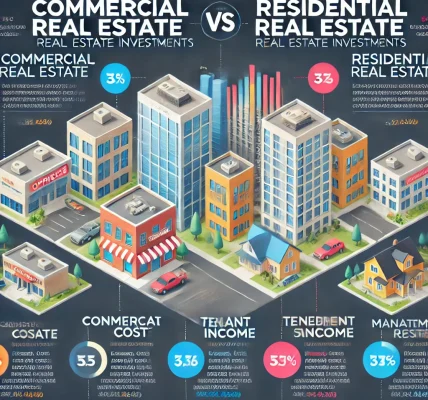Introduction
Commercial real estate (CRE) remains one of the most lucrative investment options, offering stable returns and long-term wealth-building potential. However, the landscape is constantly evolving due to economic shifts, technological advancements, and changing consumer behaviors.
In this guide, we’ll explore the latest commercial real estate trends and highlight the best investment opportunities to maximize growth.
1. Why Invest in Commercial Real Estate?
1.1 High Income Potential
Commercial properties generally offer higher rental yields compared to residential real estate, making them attractive for investors.
1.2 Long-Term Lease Agreements
Unlike residential properties, CRE leases are often signed for multiple years, ensuring a steady income stream.
1.3 Hedge Against Inflation
As inflation rises, so do property values and rental rates, allowing investors to maintain purchasing power.
1.4 Portfolio Diversification
Adding commercial properties to an investment portfolio reduces risk and balances income streams.
1.5 Tax Advantages
Depreciation, interest deductions, and other tax benefits make commercial real estate an attractive option for wealth preservation.
2. Top Commercial Real Estate Investment Trends
2.1 Rise of Mixed-Use Developments
- Mixed-use properties, combining residential, retail, and office spaces, are becoming increasingly popular.
- Investors benefit from diversified tenant bases and higher occupancy rates.
2.2 Growth of Industrial & Logistics Properties
- The e-commerce boom has fueled demand for warehouses, distribution centers, and fulfillment hubs.
- Industrial properties in major transportation hubs offer high returns due to supply chain expansion.
2.3 Smart Buildings & Technology Integration
- Commercial buildings are incorporating AI, IoT, and energy-efficient systems to enhance efficiency.
- Smart office spaces with automation and remote work solutions are in high demand.
2.4 Demand for Flexible Workspaces & Co-Working Offices
- The hybrid work model has increased the demand for co-working spaces.
- Investors can capitalize on the growing trend of flexible office solutions for startups and remote workers.
2.5 Sustainable & Green Buildings
- Eco-friendly commercial buildings with LEED certification are attracting both tenants and investors.
- Governments worldwide are offering incentives for green construction and energy-efficient properties.
3. Best Markets for Commercial Real Estate Investment
3.1 High-Growth Metropolitan Areas
- Major cities like New York, Los Angeles, and London continue to see strong demand for commercial space.
- Emerging tech hubs such as Austin, Denver, and Miami are experiencing rapid expansion.
3.2 Secondary & Tertiary Markets
- Investors are turning to mid-sized cities with lower property costs but high rental demand.
- Cities like Nashville, Charlotte, and Phoenix offer attractive investment opportunities.
3.3 Opportunity Zones
- Government-designated areas with tax incentives for real estate investments.
- Ideal for long-term investors looking for capital gains tax benefits.
3.4 Suburban Commercial Developments
- Post-pandemic migration trends have increased demand for suburban office and retail spaces.
- Investors can capitalize on mixed-use suburban developments catering to growing residential populations.
3.5 International Markets
- Countries with strong economic growth and foreign investment incentives, such as Singapore, Dubai, and Canada, offer great potential.
- Emerging markets in Southeast Asia and Eastern Europe are attracting institutional investors.
4. Key Factors to Consider Before Investing
4.1 Market Demand & Economic Trends
- Research local economic growth, employment rates, and business expansions.
- Analyze market vacancy rates and rental trends before purchasing a property.
4.2 Property Type & Tenant Stability
- Choose properties with high-demand tenant types such as logistics firms, medical offices, or technology companies.
- Ensure long-term lease agreements with reputable tenants.
4.3 Financing & Investment Costs
- Calculate total investment costs, including acquisition, maintenance, and financing.
- Explore commercial real estate loans, REITs, and crowdfunding options.
4.4 Legal & Regulatory Considerations
- Ensure compliance with zoning laws, property tax regulations, and tenant agreements.
- Consult legal professionals to mitigate risks.
4.5 Exit Strategies
- Plan for potential resale, lease renewals, or property redevelopment to maximize profits.
- Diversify investments to adapt to changing market conditions.
5. Future Outlook & Emerging Opportunities
5.1 AI & Automation in Real Estate
- AI-driven property management and predictive analytics are transforming commercial real estate operations.
- Smart lease agreements and blockchain-based transactions are gaining traction.
5.2 Demand for Healthcare & Life Sciences Properties
- Growth in the healthcare sector is driving demand for specialized medical office buildings and research labs.
- Investors can benefit from long-term stable leases with healthcare providers.
5.3 Urban Revitalization & Adaptive Reuse
- Converting old office buildings into residential or mixed-use spaces is becoming a profitable trend.
- Investors are repurposing outdated properties to meet modern tenant demands.
5.4 Remote Work & Office Space Redesign
- Traditional office spaces are being redesigned to accommodate hybrid work models.
- Flexible leasing options and shared office spaces are gaining popularity.
5.5 ESG (Environmental, Social, Governance) Investing
- Institutional investors are prioritizing sustainable and socially responsible commercial properties.
- Green financing options are becoming more accessible for eco-friendly developments.
Conclusion
Commercial real estate remains a highly profitable investment avenue, provided investors stay informed about market trends and emerging opportunities. By focusing on high-growth locations, adopting technology-driven solutions, and investing in sustainable properties, investors can maximize returns and build long-term wealth.
However, thorough research, financial planning, and risk assessment are essential before making investment decisions. Whether investing in industrial properties, co-working spaces, or mixed-use developments, strategic planning will ensure long-term success.




